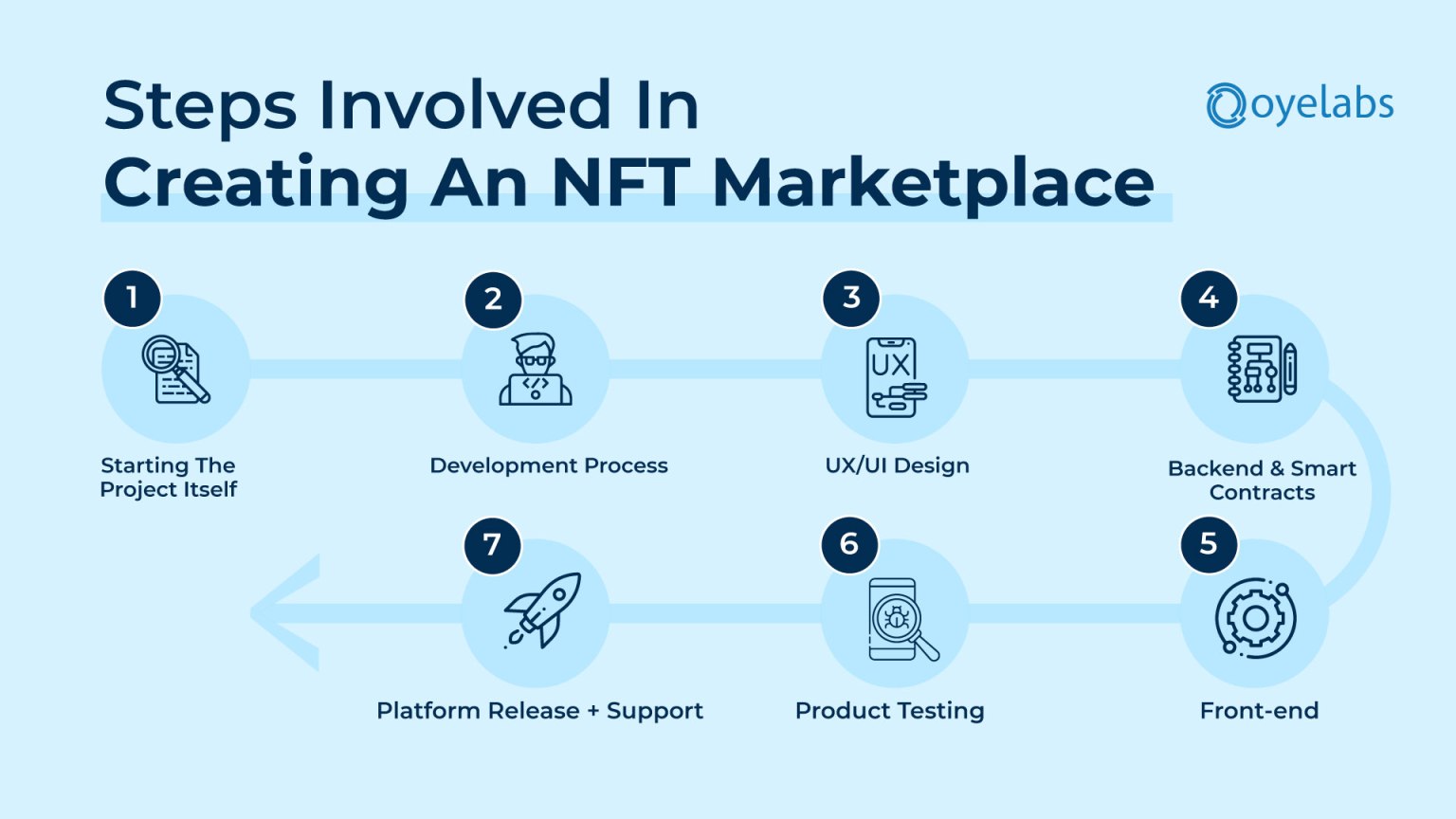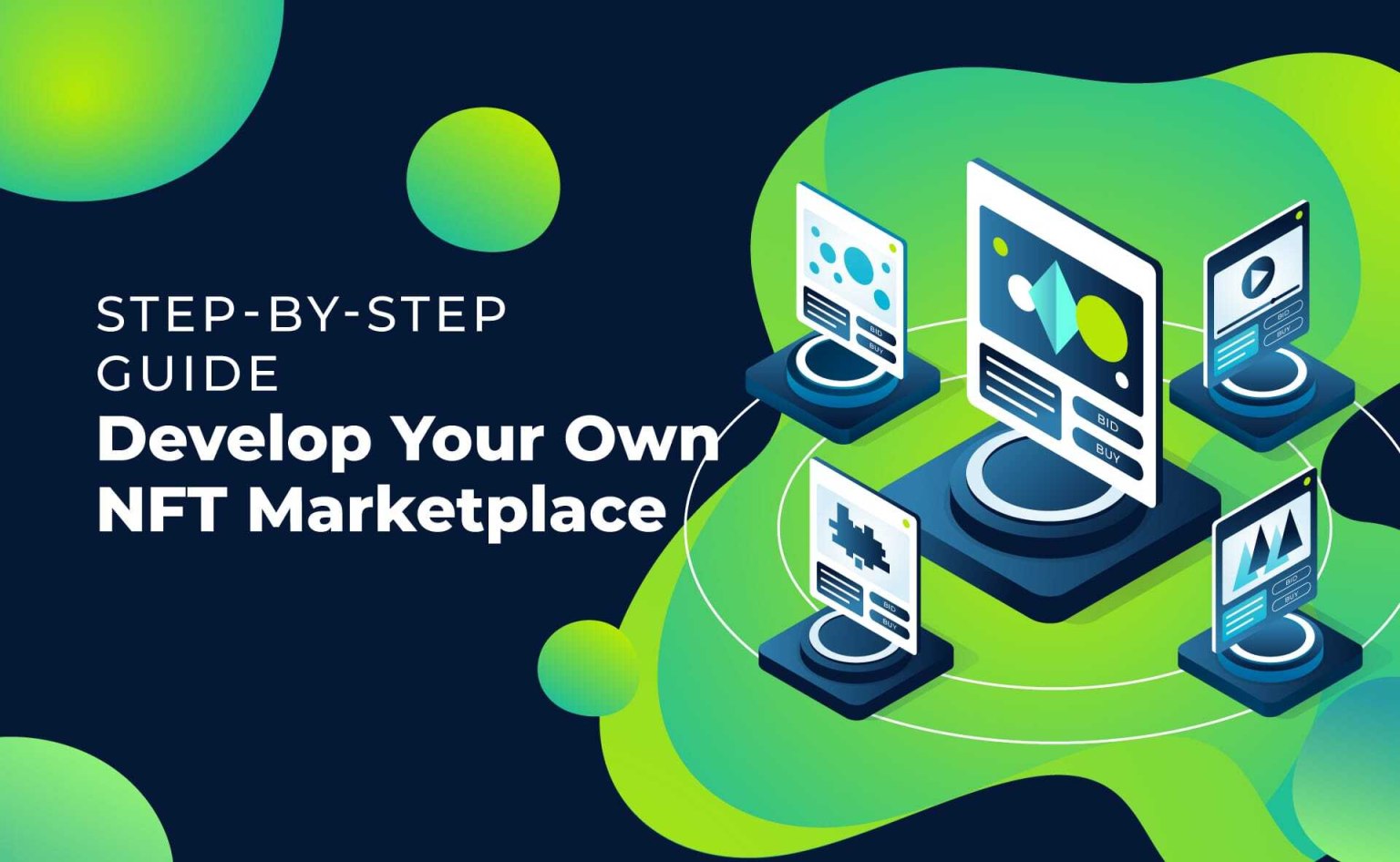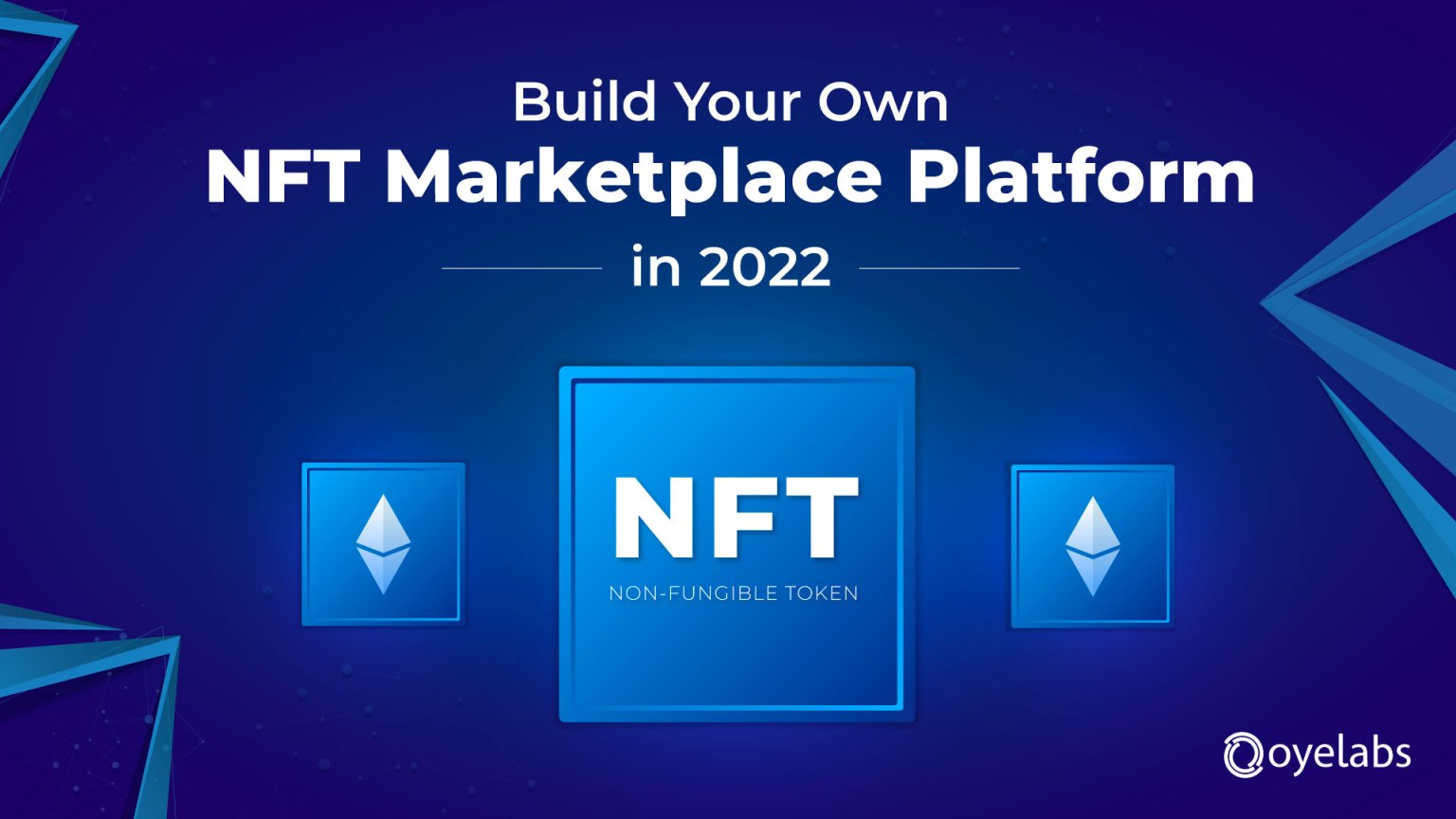How To Create Your Own NFT Marketplace
The Rise of NFTs
Greetings, NFT Enthusiast! In recent years, Non-Fungible Tokens (NFTs) have taken the world by storm. These unique digital assets have revolutionized the way we buy, sell, and trade digital goods. From artwork to collectibles, NFTs have opened up new opportunities for creators and collectors alike.
As an NFT fan, you might be wondering how to join the NFT movement and create your own marketplace. In this article, we will guide you through the process of building your own NFT marketplace, enabling you to showcase and sell your digital creations to a global audience.

Image Source: oyelabs.com
So, let’s dive into the world of NFT marketplaces and explore the steps you need to take to establish your own platform.
Table of Contents
Introduction
Understanding NFTs
Marketplace Platforms
Choosing the Right Platform
Platform Setup
Smart Contracts
Token Minting and Verification
Designing Your Marketplace
Payment Integration
Security Measures
Marketing Your Marketplace
Future Trends and Innovations
Conclusion
Understanding NFTs
🔑 Key Points:

Image Source: moralis.io
1️⃣ NFTs are unique digital assets that are stored on a blockchain.
2️⃣ They can represent various forms of digital content such as artwork, music, videos, and more.

Image Source: oyelabs.com
3️⃣ NFTs use blockchain technology to ensure rarity, ownership, and provenance.
4️⃣ Each NFT contains metadata that provides details about the asset.
5️⃣ NFTs can be bought, sold, and traded on NFT marketplaces.
6️⃣ Artists and creators can earn royalties from the resale of their NFTs.
What are NFTs?
NFT stands for Non-Fungible Token. Unlike cryptocurrencies like Bitcoin or Ethereum, which are fungible and can be exchanged on a one-to-one basis, NFTs are unique and indivisible. Each NFT has a distinct value and cannot be replaced by another token.
What can NFTs represent?
NFTs can represent a wide range of digital content, including artwork, music, videos, virtual real estate, virtual goods in video games, and more. The possibilities are limitless, and creators have the freedom to tokenize their unique creations.
How do NFTs work?
NFTs utilize blockchain technology to establish ownership, rarity, and provenance. The most common blockchain used for NFTs is Ethereum, which allows for the creation and trading of these digital assets. Each NFT is linked to a specific smart contract that defines its properties and rules.
What is metadata in NFTs?
Metadata is essential for NFTs as it contains information about the asset, such as the creator, title, description, and other relevant details. This data ensures transparency and provides additional context for potential buyers and collectors.
Where can you buy and sell NFTs?
NFTs are primarily traded on NFT marketplaces. These platforms serve as the go-to destinations for collectors and artists to showcase and sell their NFT creations. Some popular NFT marketplaces include OpenSea, Rarible, and SuperRare.
Marketplace Platforms
🔑 Key Points:
1️⃣ There are various marketplace platforms available for creating your own NFT marketplace.
2️⃣ Open-source platforms provide flexibility and customization options.
3️⃣ Turnkey solutions offer convenience but may have limitations.
4️⃣ Consider factors like features, security, scalability, and community support when choosing a platform.
When it comes to building your own NFT marketplace, you have several options to consider. There are open-source platforms that provide you with greater flexibility and customization options, allowing you to tailor your marketplace to your specific needs. Examples of open-source platforms include Mintable and NFT-Project.
On the other hand, turnkey solutions offer convenience and ease of use. These platforms come with pre-built templates and functionalities, making it easier for you to launch your marketplace without extensive technical knowledge. Some popular turnkey solutions for NFT marketplaces include Rarible Clone and OpenSea Clone.
When choosing a marketplace platform, there are several factors to consider:
✅ Features: Look for platforms that offer the features you need, such as smart contract integration, user profiles, bidding options, and more.
✅ Security: Ensure that the platform has robust security measures in place to protect the assets and transactions on your marketplace.
✅ Scalability: Consider the platform’s scalability to handle growing user traffic and the increasing demand for NFTs.
✅ Community Support: Check if the platform has an active and supportive community that can assist you with any technical issues or queries.
Choosing the Right Platform
🔑 Key Points:
1️⃣ Assess your requirements and goals before selecting a marketplace platform.
2️⃣ Consider factors like budget, technical expertise, and customization options.
3️⃣ Research platforms and read user reviews to make an informed decision.
Choosing the right platform for your NFT marketplace is crucial. Before making a decision, assess your requirements and goals. Consider factors such as your budget, technical expertise, and the level of customization you desire.
Research various marketplace platforms and read user reviews to gain insights into the user experience and satisfaction. Look for platforms that align with your vision and provide the necessary features and support to help your marketplace thrive.
Remember, the platform you choose will be the foundation of your NFT marketplace, so take your time and make an informed decision that aligns with your long-term goals.
Platform Setup
🔑 Key Points:
1️⃣ Set up an account on your chosen marketplace platform.
2️⃣ Complete your profile and provide accurate information.
3️⃣ Customize your marketplace’s branding, layout, and design.
4️⃣ Ensure that your marketplace is user-friendly and intuitive to navigate.
5️⃣ Test the functionality of your marketplace before launching it.
Once you have chosen a marketplace platform, the next step is to set up your account. Sign up on the platform’s website and follow the registration process. Provide accurate information and complete your profile, as this will help build trust with potential buyers and sellers.
Customize your marketplace’s branding, layout, and design to create a unique and visually appealing platform. Consider your target audience and their preferences when designing your marketplace. Ensure that the user interface is user-friendly, intuitive, and easy to navigate.
Before launching your marketplace, thoroughly test its functionality. Ensure that all features are working correctly, and there are no bugs or glitches. Seek feedback from beta testers to identify any areas for improvement.
Smart Contracts
🔑 Key Points:
1️⃣ Smart contracts are self-executing contracts that facilitate transactions on the blockchain.
2️⃣ Utilize existing smart contract templates or create your own.
3️⃣ Ensure that your smart contracts are secure and audited by professionals.
4️⃣ Test your smart contracts thoroughly before deploying them.
Smart contracts play a crucial role in NFT marketplaces as they facilitate transactions between buyers and sellers. These self-executing contracts are stored on the blockchain and automatically execute the terms of the agreement.
When building your NFT marketplace, you can choose to utilize existing smart contract templates or create your own from scratch. Several platforms offer pre-built smart contract templates that you can customize to suit your marketplace’s needs. Alternatively, you can work with a team of blockchain developers to create a custom smart contract tailored specifically to your requirements.
Security is paramount when it comes to smart contracts. Ensure that your smart contracts are audited by professionals to identify and address any vulnerabilities or security loopholes. Testing the functionality and reliability of your smart contracts is crucial to ensure smooth and secure transactions on your marketplace.
Token Minting and Verification
🔑 Key Points:
1️⃣ Token minting involves the creation of unique tokens on the blockchain.
2️⃣ Implement a verification process to ensure the authenticity of the tokens.
3️⃣ Clearly define the minting and verification process for your marketplace.
4️⃣ Consider integrating metadata to provide additional information about the tokens.
Token minting is the process of creating unique tokens on the blockchain. This step involves associating the metadata with the token and ensuring its uniqueness. Implement a verification process to authenticate the tokens and prevent counterfeits or duplicates from being listed on your marketplace.
Clearly define the minting and verification process for your marketplace. Establish guidelines and criteria for token creation and ensure that every listed token meets the necessary standards. This will help maintain the quality and authenticity of the tokens available on your marketplace.
Consider integrating metadata into your tokens. Metadata provides additional information about the token, such as the creator, description, and relevant details. This information enhances the value and desirability of the tokens, providing potential buyers with more context and insight.
Designing Your Marketplace
🔑 Key Points:
1️⃣ Design a visually appealing and user-friendly marketplace interface.
2️⃣ Use consistent branding elements and imagery throughout the platform.
3️⃣ Focus on creating an intuitive navigation system for easy exploration.
4️⃣ Optimize the marketplace for mobile devices for a seamless user experience.
The design of your marketplace plays a crucial role in attracting and engaging users. Aim for a visually appealing interface that aligns with your marketplace’s theme and target audience. Use consistent branding elements and imagery to create a cohesive and memorable experience.
An intuitive navigation system is essential for users to explore and discover the NFTs available on your marketplace. Categorize and organize the listings in a logical and user-friendly manner. Implement search filters and sorting options to enhance the user experience.
With the increasing use of mobile devices, it is crucial to optimize your marketplace for mobile responsiveness. Ensure that your marketplace is accessible and provides a seamless user experience across different screen sizes and devices.
Payment Integration
🔑 Key Points:
1️⃣ Integrate secure and reliable payment gateways into your marketplace.
2️⃣ Offer multiple payment options to cater to a wider range of users.
3️⃣ Implement a secure escrow system for smooth and transparent transactions.
4️⃣ Ensure compliance with relevant financial regulations and laws.
Payment integration is a critical aspect of any marketplace. Integrate secure and reliable payment gateways into your platform to allow users to buy and sell NFTs seamlessly. Offer multiple payment options, such as credit cards, cryptocurrencies, and digital wallets, to cater to a wider range of users.
To ensure smooth and transparent transactions, consider implementing an escrow system. An escrow system holds the funds until the agreed-upon conditions are met, protecting both the buyer and the seller. This adds an extra layer of security and builds trust within the marketplace.
Compliance with relevant financial regulations and laws is crucial when dealing with payments. Familiarize yourself with the legal requirements and ensure that your marketplace follows all necessary guidelines and regulations to operate lawfully and ethically.
Security Measures
🔑 Key Points:
1️⃣ Implement robust security measures to protect user data and assets.
2️⃣ Use encryption and secure protocols to safeguard sensitive information.
3️⃣ Regularly update and patch your marketplace to address any security vulnerabilities.
4️⃣ Provide guidelines for users to enhance their security practices.
Ensuring the security of your marketplace is of utmost importance. Implement robust security measures to protect user data and assets from potential threats and attacks. Utilize encryption and secure protocols to safeguard sensitive information, such as user credentials and payment details.
Regularly update and patch your marketplace’s software to address any security vulnerabilities. Stay informed about the latest security practices and trends to mitigate potential risks. Conduct regular security audits and penetration testing to identify and fix any weaknesses in your system.
Additionally, provide guidelines for users on how to enhance their security practices. Educate them about the importance of strong passwords, two-factor authentication, and other security measures to protect their accounts and assets.
Marketing Your Marketplace
🔑 Key Points:
1️⃣ Develop a comprehensive marketing strategy to promote your marketplace